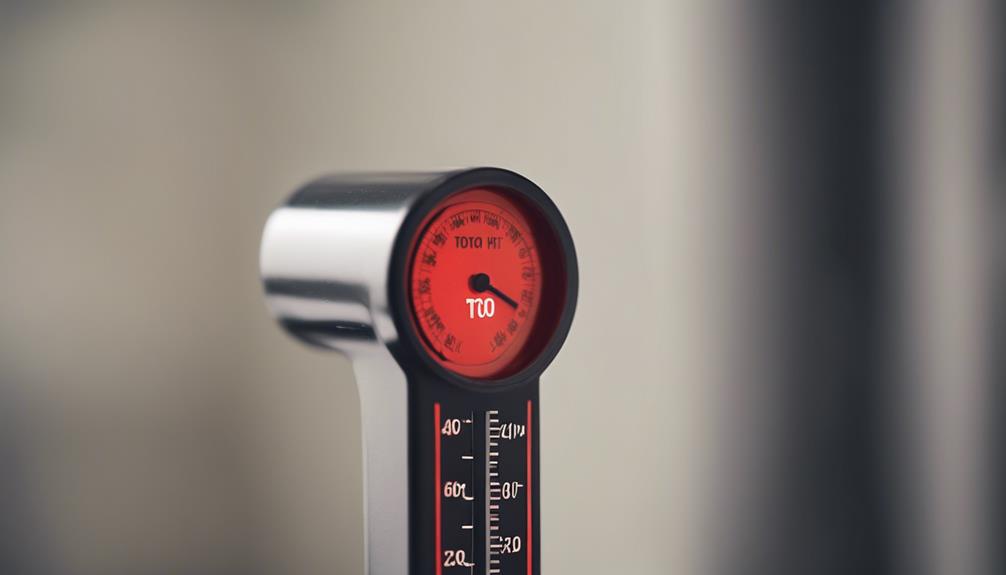As pet owners, understanding the threshold at which temperatures become hazardous for our canine companions is crucial. Experts in the field offer valuable insights into the nuanced world of canine thermoregulation and the potential risks associated with excessive heat exposure.
By examining factors such as breed susceptibility, signs of heat-related distress, and practical safety measures, dog owners can equip themselves with the knowledge needed to protect their furry friends during warmer seasons.
Stay tuned to uncover the expert recommendations and proactive steps necessary to ensure the well-being of your beloved pets in challenging weather conditions.
Key Takeaways
- Dogs should avoid temperatures exceeding 90°F to prevent heatstroke.
- Check pavement temperature before walks to protect paw pads.
- Provide shade, water, and cooling options for dogs in hot weather.
- Never leave a dog in a car, especially in temperatures over 70°F.
Normal Body Temperature of Dogs
The normal body temperature range for dogs typically falls between 101°F to 102.5°F. Monitoring your dog's temperature is crucial for assessing their health status. A dog's body temperature can vary slightly depending on factors like breed, age, and activity level.
It is essential to be aware of your dog's baseline temperature to detect any deviations that may indicate an underlying health issue. Understanding your dog's normal temperature range can help you identify potential problems early on and seek veterinary care if necessary.
Regular temperature checks, especially during hot weather, can aid in preventing heat-related illnesses such as heatstroke. By staying informed about your dog's temperature range, you can better ensure their well-being and comfort in various environmental conditions.
Thermoneutral Zone for Dogs
Within the realm of canine physiology, the thermoneutral zone denotes the temperature range in which dogs can maintain their body temperature without expending extra energy. This zone is crucial for dogs to function optimally and avoid heat-related issues.
To delve further into this topic, let's explore some key points:
- Optimal Temperature Range: Dogs thrive best in temperatures ranging from 68°F to 86°F, where they can regulate their body temperature efficiently.
- Energy Conservation: Within the thermoneutral zone, dogs do not need to use additional energy to cool or warm themselves, allowing for normal physiological functions.
- Importance of Monitoring: It is essential for pet owners to be aware of the thermoneutral zone to ensure their dogs are comfortable and safe in various weather conditions.
Factors Affecting Heat Tolerance

Factors influencing dogs' heat tolerance include their breed, size, and level of physical activity. Different breeds have varying heat tolerances, with brachycephalic breeds being more sensitive to heat due to their anatomy. Smaller dogs generally struggle more in hot weather compared to larger breeds. Additionally, dogs that are highly active or have thick fur may be less tolerant of heat. Understanding these factors can help owners make informed decisions to protect their pets from overheating.
| Breed | Size | Activity Level |
|---|---|---|
| Brachycephalic | Small | High |
| Husky | Large | Moderate |
| Pug | Small | Low |
| Golden Retriever | Large | High |
| Shih Tzu | Small | Low |
Risks for Brachycephalic Breeds
Brachycephalic breeds, due to their unique anatomical features, are particularly susceptible to heat-related issues. These breeds have a flattened face and narrowed airways, which can impede their ability to regulate body temperature effectively. When exposed to high temperatures, brachycephalic breeds face increased risks of heatstroke and heat exhaustion.
To mitigate these risks, owners of brachycephalic dogs should take extra precautions during hot weather, such as:
- Providing ample shade and cool resting areas.
- Ensuring access to fresh water at all times.
- Avoiding strenuous exercise during the hottest parts of the day.
Signs of Heatstroke in Dogs

Given the heightened susceptibility of brachycephalic breeds to heat-related issues, it is vital for dog owners to be vigilant and recognize the signs of heatstroke in their pets. Heatstroke can be life-threatening and requires immediate attention.
Signs of heatstroke in dogs include excessive panting, drooling, rapid heartbeat, glazed eyes, dizziness or lack of coordination, vomiting, diarrhea, and in severe cases, seizures or loss of consciousness. If you suspect your dog is suffering from heatstroke, move them to a cool, shaded area, offer water to drink, and wet their body with cool water.
Contact a veterinarian promptly for further guidance and treatment to prevent complications. Understanding these signs can help save your dog's life during hot weather.
Checking Pavement Temperature
To ensure your dog's safety during hot weather, it is crucial to assess the temperature of the pavement before allowing your pet to walk on it. Here are three essential tips for checking pavement temperature:
- Hand Test: Place the back of your hand on the pavement for 7 seconds to gauge if it's too hot for your dog.
- Barefoot Test: Press your bare foot on the pavement for 7 seconds to feel the heat intensity.
- Temperature Gun: Use a temperature gun to measure the pavement temperature accurately before taking your dog out for a walk.
Limiting Physical Activity on Hot Pavement

During periods of hot weather, it is imperative to restrict the level of physical activity that dogs engage in on hot pavement to prevent potential harm to their paw pads.
| Why Limit Physical Activity? | Benefits |
|---|---|
| Prevents paw pad burns and injuries | Protects dogs' well-being |
| Reduces the risk of heat-related issues | Ensures dogs' comfort |
| Minimizes discomfort for the dog | Prevents costly vet visits |
| Promotes safer outdoor experiences | Increases overall safety |
Using Protective Gear for Paw Pads
When ensuring the well-being of dogs during hot weather, utilizing protective gear for their paw pads is essential to prevent injuries and enhance their comfort outdoors. Here are three crucial points to consider when using protective gear for paw pads:
- Choose the Right Fit: Ensuring the protective gear fits snugly but comfortably on your dog's paws is vital for effectiveness.
- Quality Material: Opt for protective gear made from breathable and durable materials to prevent overheating and withstand outdoor conditions.
- Regular Inspections: Check the protective gear frequently for any signs of wear and tear to ensure continued protection for your dog's paw pads.
Optimal Walking Times for Dogs

For dogs, determining the optimal times for walking is crucial in ensuring their comfort and safety during outdoor activities. The best times to walk your dog are either early in the morning or later in the evening when temperatures are cooler. During these times, the pavement is less likely to be hot, reducing the risk of paw pad burns or heat-related issues.
Morning walks can also provide a peaceful start to the day, while evening walks can help your dog unwind before bedtime. By choosing the optimal walking times, you can ensure that your dog enjoys their outdoor exercise while minimizing the risks associated with hot weather. Remember to always prioritize your dog's well-being when planning outdoor activities.
Alternative Exercise Options
To ensure your dog's well-being during hot weather, exploring alternative exercise options beyond traditional walks becomes essential for maintaining their comfort and safety.
Here are three alternative exercise options to keep your dog active and cool in hot weather:
- Swimming: Take your dog for a swim in a pet-friendly pool or a safe body of water to provide a fun and low-impact exercise option.
- Indoor Play Sessions: Engage in interactive indoor games like fetch, tug-of-war, or hide-and-seek to keep your dog physically active without exposure to outdoor heat.
- Canine Enrichment Activities: Stimulate your dog's mind with puzzle toys, scent games, or obedience training indoors to provide mental exercise while avoiding the heat outside.
Providing Shade and Water

Amid rising temperatures, ensuring adequate access to shade and water is paramount for safeguarding your dog's well-being in hot weather.
When your dog is outdoors, provide a sheltered area with ample shade where they can rest and cool down. Consider using a dog house, a canopy, or natural shade from trees to create a comfortable spot.
Additionally, always make sure there is a plentiful supply of fresh, cool water available for your furry friend. Check the water bowl regularly to ensure it is clean and refill it as needed, especially on hot days when your dog may be drinking more.
Indoor Activities for Hot Weather
During scorching temperatures, it is essential to engage your dog in indoor activities to ensure their comfort and safety. Consider the following indoor activities to keep your furry friend entertained and cool:
- Puzzle Toys: Challenge your dog's mind with interactive puzzle toys that dispense treats, providing mental stimulation without physical exertion.
- Indoor Fetch: Clear a safe space indoors for a game of fetch using soft toys or balls to avoid potential accidents or damage to your home.
- Training Sessions: Use the opportunity to work on obedience training or teach new tricks in the comfort of your air-conditioned home, strengthening your bond while keeping your dog mentally engaged.
Cooling Strategies for Dogs

Utilizing effective cooling strategies is imperative to safeguarding dogs against heat-related issues and ensuring their well-being in warm weather conditions. When temperatures rise, it's crucial to help your furry friend stay cool. Here are some practical cooling methods for dogs:
| Cooling Strategies | Description | Benefits |
|---|---|---|
| Frozen Treats | Make watermelon mint pupsicles or doggie ice cream to provide a refreshing snack | Keeps dogs hydrated |
| Fresh Water | Offer plenty of water to prevent dehydration and regulate body temperature | Essential for well-being |
| Cooling Mats or Vests | Use specialized mats or vests to help lower your dog's body temperature | Provides targeted cooling |
| Sprinkler or Dog Pool | Allow your dog to cool off under a sprinkler or in a doggie pool | Fun way to beat the heat |
| Proactive Measures | Take steps to ensure your dog stays cool and comfortable in hot weather | Prevents heat-related issues |
Conclusion
In conclusion, understanding the normal body temperature of dogs, their thermoneutral zone, and the factors affecting their heat tolerance is crucial in ensuring their well-being in hot weather.
It is important to be aware of the risks for brachycephalic breeds and to recognize the signs of heatstroke in dogs.
By providing shade, water, and alternative exercise options, as well as implementing cooling strategies, dog owners can help their pets stay safe and comfortable during hot temperatures.




